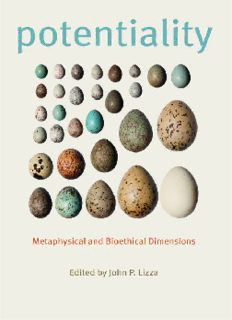
Potentiality: Metaphysical and Bioethical Dimensions PDF
Preview Potentiality: Metaphysical and Bioethical Dimensions
Potentiality This page intentionally left blank Potentiality: Metaphysical and Bioethical Dimensions Edited by John P. Lizza Johns Hopkins University Press Baltimore © 2014 Johns Hopkins University Press All rights reserved. Published 2014 Printed in the United States of America on acid- free paper 2 4 6 8 9 7 5 3 1 Johns Hopkins University Press 2715 North Charles Street Baltimore, Mary land 21218- 4363 www .press .jhu .edu Cataloging-in-Publication data is on fi le at the Library of Congress. A cata log record for this book is available from the British Library. ISBN 978-1-4214-1174-3 (pbk : acid-free paper) ISBN 1-4214-1174-1 (pbk : acid-free paper) Special discounts are available for bulk purchases of this book. For more information, please contact Special Sales at 410- 516- 6936 or [email protected]. Johns Hopkins University Press uses environmentally friendly book materials, including recycled text paper that is composed of at least 30 percent post- consumer waste, whenever possible. Contents Ac know ledg ments vii Introduction 1 John P. Lizza Part I The Nature of Potentiality 1 Aristotle’s Theory of Potentiality 29 Mohan Matthen 2 Dispositions and Potentialities 49 Jennifer McKitrick 3 The Paradoxes of Potentiality 69 Joel Feinberg 4 Physical Possibility and Potentiality in Ethics 72 Edward Covey 5 Abortion: Listening to the Middle 84 Edward Langerak Part II Potentiality at the Beginning of Life 6 Persons with Potential 97 Jason T. Eberl 7 The Moral Status of Stem Cells 120 Agata Sagan and Peter Singer 8 Potential 140 Jeff McMahan vi Contents 9 Abortion and the Margins of Personhood 174 Margaret Olivia Little 10 Revisiting the Argument from Fetal Potential 191 Bertha Alvarez Manninen Part III Potentiality at the End of Life 11 Are DCD Donors Dead? 223 Don Marquis 12 The Irreversibility of Death: Metaphysical, Physiological, Medical or Ethical? 237 Tom Tomlinson 13 On the Ethical Relevance of Active versus Passive Potentiality 250 John P. Lizza List of Contributors 271 Index 273 Acknowledgments I would like to thank the staff of The Hastings Center, as inspiration for this work came while I was a visiting scholar at the Center in the summer of 2009. I have bene- fi ted greatly from my association with the Center for many years. I would also like to thank the Pennsylvania State System of Higher Education for a summer research grant that enabled me to work on this project. I am indebted to the conversations on potentiality that I have had with many of the contributors to this volume, my col- leagues, and others, especially Allan Bäck, Daniel Callahan, Jason Eberl, David Hershenov, Joseph Jedwab, Bertha Alvarez Manninen, Mohan Matthen, Jennifer McKitrick, Alan Shewmon, and Tom Tomlinson. I thank them for their generous time, patience, and insights. I would also like to thank Laurel Delaney, secretary of the Philosophy Department at Kutztown University, for her help in assisting with obtaining materials and tireless proofreading, and two students, Crystal Williams and Jenn Dum, for their help with or ga niz ing materials and checking bibliographical references. Finally, I was fortunate to have a great editor in the person of Matt Mc- Adam at Johns Hopkins University Press. I gratefully acknowledge permission from the following authors and publishers to reprint material from previously published work: Chapter 3. Joel Feinberg, “The Paradoxes of Potentiality,” Appendix from Joel Feinberg, “The Rights of Animals and Unborn Generations,” in William T. Black- stone, ed., Philosophy & Environmental Crisis, University of Georgia Press (1974): 67– 68. Chapter 4. Edward Covey, “Physical Possibility and Potentiality in Ethics,” American Philosophical Quarterly 28:3 (1991): 237– 44. Chapter 5. Edward Langerak, “Listening to the Middle,” Hastings Center Report 9:5 (1979): 24– 28. Chapter 7. Agata Sagan and Peter Singer, “The Moral Status of Stem Cells,” Metaphilosophy 36:2– 3 (2007): 265–8 4. viii Acknowledgments Chapter 8. Jeff McMahan, “Potential,” in Jeff McMahan, The Ethics of Killing, Oxford University Press (2007): 302– 29. Chapter 9. Margaret Olivia Little, “Abortion and the Margins of Personhood,” Rutgers Law Journal 39 (2008): 331– 48. Chapter 10. Bertha Alvarez Manninen, “Revisiting the Argument from Poten- tial,” Philosophy, Ethics, and Humanities in Medicine 2:7 (2007), www .peh -med .com /content /2 /1 /7 . Chapter 11. Don Marquis, “Are DCD Donors Dead?” Hastings Center Report 40:3 (2010): 24– 31. Chapter 13. John P. Lizza, “The Ethical Relevance of Active versus Passive Poten- tiality,” APA Newsletter on Philosophy and Medicine 11:1 (2011): 22– 28. www .apaonline .org /APAOnline /Publications /Newsletters /Past _Newsletters /Vol11 /Vol _11 .aspx . Potentiality
Description: